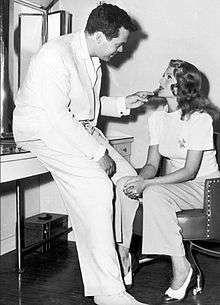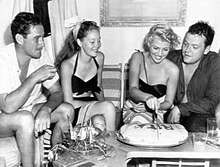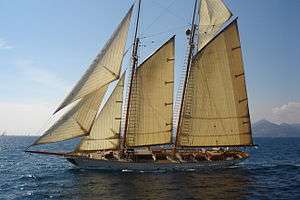The Lady from Shanghai
The Lady from Shanghai is a 1947 film noir directed by Orson Welles and starring Welles, his estranged wife Rita Hayworth and Everett Sloane.[2] It is based on the novel If I Die Before I Wake by Sherwood King.
| The Lady from Shanghai | |
|---|---|
.jpg) Theatrical release poster | |
| Directed by | Orson Welles |
| Produced by | Orson Welles |
| Screenplay by | Orson Welles Uncredited: William Castle Charles Lederer Fletcher Markle |
| Based on | If I Die Before I Wake 1938 novel by Raymond Sherwood King |
| Starring | |
| Narrated by | Orson Welles |
| Music by | Heinz Roemheld |
| Cinematography |
|
| Edited by | Viola Lawrence |
Production company | Mercury Productions |
| Distributed by | Columbia Pictures |
Release date | December 24, 1947 (France) June 9, 1948 (US) |
Running time | 88 minutes |
| Country | United States |
| Language | English |
| Box office | 1,564,609 admissions (France)[1] |
Although The Lady from Shanghai initially received mixed reviews, it has grown in stature over the years, and many critics have praised its set designs and camerawork. In 2018, The Lady from Shanghai was selected for preservation in the United States National Film Registry as being "culturally, historically, or aesthetically significant."
Plot
Irish sailor Michael O'Hara meets the beautiful blonde Elsa as she rides a horse-drawn coach in Central Park. Three hooligans waylay the coach. Michael rescues Elsa and escorts her home. Michael reveals he is a seaman and learns Elsa and her husband, disabled criminal defense attorney Arthur Bannister, are newly arrived in New York City from Shanghai. They are on their way to San Francisco via the Panama Canal. Michael, attracted to Elsa despite misgivings, agrees to sign on as an able seaman aboard Bannister's yacht.
They are joined on the boat by Bannister's partner, George Grisby, who proposes that Michael "murder" him in a plot to fake his own death. He promises Michael $5,000 and explains that since he would not really be dead and since there would be no corpse, Michael could not be convicted of murder (reflecting corpus delicti laws at the time). Michael agrees, intending to use the money to run away with Elsa. Grisby has Michael sign a confession.
On the night of the crime, Sydney Broome, a private investigator who has been following Elsa on her husband's orders, confronts Grisby. Broome has learned of Grisby's plan to murder Bannister, frame Michael, and escape by pretending to have also been murdered. Grisby shoots Broome and leaves him for dead. Unaware of what has happened, Michael proceeds with the night's arrangement and sees Grisby off on a motorboat before shooting a gun into the air to draw attention to himself. Meanwhile, Broome, mortally wounded but still alive, asks Elsa for help. He warns her that Grisby intends to kill her husband.
Michael makes a phone call to Elsa, but finds Broome on the other end of the line. Broome warns Michael that Grisby was setting him up. Michael rushes to Bannister's office in time to see Bannister is alive, but that the police are removing Grisby's body from the premises. The police find evidence implicating Michael, including his confession, and take him away.
At trial, Bannister acts as Michael's attorney. He feels he can win the case if Michael pleads justifiable homicide. During the trial, Bannister learns of his wife's relationship with Michael. He ultimately takes pleasure in his suspicion that they will lose the case. Bannister also indicates that he knows the real killer's identity. Before the verdict, Michael escapes by feigning a suicide attempt (swallowing pain relief pills Bannister takes for his disability), causing a commotion in which he slips out of the building with the jury for another case. Elsa follows. Michael and she hide in a Chinatown theater. Elsa calls some Chinese friends to meet her. As Michael and Elsa wait and pretend to watch the show, Michael realizes that she killed Grisby. Michael passes out from the pills he took just as Elsa's Chinese friends arrive; they carry the unconscious Michael to an empty fun house. When he wakes, he realizes that Grisby and Elsa had been planning to murder Bannister and frame him for the crime, but that Broome's involvement ruined the scheme and that Elsa had to kill Grisby for her own protection.
The film features a unique climactic shootout in a hall of mirrors involving a multitude of false and real mirrored images in the Magic Mirror Maze, in which Elsa is mortally wounded and Bannister is killed. Heartbroken, and ignoring Elsa's pleas to save her life, Michael leaves presuming that events which have unfolded since the trial will clear him of any crimes. "Maybe I'd forget her. Maybe I'd die trying".
Cast
- Rita Hayworth as Elsa "Rosalie" Bannister
- singing voice was dubbed by Anita Kert Ellis
- Orson Welles as Michael O'Hara
- Everett Sloane as Arthur Bannister
- Glenn Anders as George Grisby
- Ted de Corsia as Sidney Broome
- Erskine Sanford as Judge
- Gus Schilling as "Goldie" Goldfish
- Carl Frank as District Attorney Galloway
- Louis Merrill as Jake
- Evelyn Ellis as Bessie
- Harry Shannon as Cab Driver
- Errol Flynn as Man in Background Outside of Cantina (uncredited)
- Philip Morris as Port Steward/Officer Peters (uncredited)
- Edward Peil Sr. as Guard (uncredited)
Production
In the summer of 1946, Welles was directing a musical stage version of Around the World in Eighty Days, with a comedic and ironic rewriting of the Jules Verne novel by Welles, incidental music and songs by Cole Porter, and production by Mike Todd, who would later produce the successful film version with David Niven.
When Todd pulled out from the lavish and expensive production, Welles financed it. When he ran out of money and urgently needed $55,000 to release costumes which were being held, he convinced Columbia Pictures president Harry Cohn to send him the money to continue the show and in exchange Welles promised to write, produce and direct a film for Cohn for no further fee. As Welles tells it, on the spur of the moment, he suggested the film be based on a book that he happened to see in front of him during his call with Cohn, one a girl in the theatre box office was reading at the time. Welles had never read it.[3] However, according to the daughter of William Castle, it was her father who had purchased the film adaptation rights for the novel and who then asked Welles to pitch it to Cohn, with Castle hoping to receive the directoral assignment himself. She described her father as greatly respecting Welles' talents, but feeling nonetheless disappointed at being relegated to serve merely as Welles' assistant director on the film.[4]

The Lady from Shanghai began filming on 2 October 1946, and originally finished filming on 27 February 1947, with studio-ordered retakes continuing through March 1947—but it was not released in the U.S. until 9 June 1948. Cohn strongly disliked Welles's rough cut, particularly what he considered to be a confusing plot and lack of close-ups (Welles had deliberately avoided these, as a stylistic device), and was not in sympathy with Welles's Brechtian use of irony and black comedy, especially in a farcical courtroom scene. He also objected to the appearance of the film—Welles had aimed for documentary-style authenticity by shooting one of the first major Hollywood pictures almost entirely on location (in Acapulco, Pie de la Cuesta, Sausalito and San Francisco) using long takes, and Cohn preferred the more tightly-controlled look of footage lit and shot in a studio. Release was delayed due to Cohn order for extensive editing and reshoots. Whereas Welles had delivered his cut of the film on time and under budget, the reshoots Welles was ordered to do meant that the film ended up over budget by a third, contributing to the director's reputation for going over budget. Once the reshoots were over, the heavy editing ordered by Cohn took over a year to complete; editor Viola Lawrence cut about an hour from Welles's rough cut.[5][6] Welles was appalled at the musical score and particularly aggrieved by the cuts to the climactic confrontation scene in an amusement park funhouse at the end of the film. Intended as a climactic tour-de-force of editing and production design, the scene was cut to fewer than three minutes out of an intended running time of twenty. As with many of Welles's films over which he did not have control over the final cut, the missing footage has not been found and is presumed to have been destroyed. Surviving production stills show elaborate and expensive sets built for the sequence which were entirely cut from the film.[7]
Welles cast his wife Rita Hayworth as Elsa and caused controversy when he instructed her to cut her long red hair and bleach it blonde for the role. "Orson was trying something new with me, but Harry Cohn wanted The Image—The Image he was gonna make me 'til I was 90," Rita Hayworth recalled. "The Lady from Shanghai was a very good picture. So what does Harry Cohn say when he sees it? 'He's ruined you—he cut your hair off!'"[8]
The film was considered a disaster in America at the time of its release, though the closing shootout in a hall of mirrors has since become one of the touchstones of film noir. Not long after release, Welles and Hayworth finalized their divorce.
A remake of the film came close to production at the turn of the century from a screenplay written by Jeff Vintar, based both on the Orson Welles script and the original pulp novel, produced by John Woo and Terence Chang, and starring Brendan Fraser, who wanted Michael Douglas and Catherine Zeta-Jones to co-star. Although the screenplay was considered highly successful, and Fraser was coming off the highly praised Gods and Monsters, the project was abandoned when the head of Sony Pictures, Amy Pascal, decided to concentrate on teen films.
Filming locations


In addition to the Columbia Pictures studios, the film was partly shot on location in San Francisco. It features the Sausalito waterfront and Sally Stanford's Valhalla waterfront bar and cafe,[9] the front, interior, and a courtroom scene of the old Kearny Street Hall of Justice, and shots of Welles running across Portsmouth Square, escaping to a long scene in a theater in Chinatown, then the Steinhart Aquarium in Golden Gate Park, and Whitney's Playland-at-the-Beach amusement park at Ocean Beach for the hall of mirrors scene, for which interiors were shot on a soundstage.
Other scenes were filmed in Acapulco. The yacht Zaca, on which many scenes take place, was owned by actor Errol Flynn, who skippered the yacht in between takes and can also be seen in the background in one scene at a cantina in Acapulco.[10]
Critical reaction
Reviews for The Lady from Shanghai were initially mixed. Variety magazine found the script wordy and noted that the "rambling style used by Orson Welles has occasional flashes of imagination, particularly in the tricky backgrounds he uses to unfold the yarn, but effects, while good on their own, are distracting to the murder plot."[11]
Satyajit Ray called it the first atonal film made in the history of cinema.
A more recent Time Out Film Guide review states that Welles simply didn't care enough to make the narrative seamless: "the principal pleasure of The Lady from Shanghai is its tongue-in-cheek approach to story-telling."[12] One recent book on Film Noir praises the film for its pervasive atmosphere of malaise and its impressive, extraordinary technical mastery.[13]
Although The Lady From Shanghai was acclaimed in Europe, it was not embraced in the U.S. until several decades later. Review aggregator Rotten Tomatoes reports an 82% approval from critics, and an average rating of 8.12/10.[14] Influential modern critics including David Kehr have subsequently declared it a masterpiece, with Kehr calling it "the weirdest great movie ever made."[15] In the British Film Institute's 2012 Sight & Sound poll, six critics each ranked it one of the 10 greatest films of all time.[16]
In popular culture
The climactic hall of mirrors sequence has entered the narrative of cinema as a trope, replicated countless times in both film and television.[17][18] Examples include:
- The 1965 television episode of The Avengers entitled "Too Many Christmas Trees", and broadcast on Christmas Day in the UK, features Steed (Patrick Macnee) and Mrs Peel (Diana Rigg) confronting their nemesis in a hall of mirrors shoot-out.
- In the 1970 television episode of Randall and Hopkirk (Deceased) entitled "Vendetta for a Dead Man", Eric Jansen (George Sewell) menaces Jeannie Hopkirk (Annette Andre) in a hall of mirrors.
- In the 1973 Robert Clouse film Enter the Dragon, Bruce Lee's character fights the villain Mr. Han in a hall of mirrors.
- In the 1984 Sergio Leone film Once Upon A Time In America, Robert DeNiro's character Noodles hides out in a Chinese theatre, a front for an opium den, alluding to a scene in which Orson Welles' character hides out in a Chinese theatre to evade the law.
- The 1989 MacGyver episode "Brainwashed" has a scene involving MacGyver's brainwashed friend, Jack Dalton, shooting at him in a hall of mirrors.[19] Episode writer John Sheppard credited The Lady From Shanghai as an influence.[20]
- In the 1989 movie Ghostbusters II (1989), Rick Moranis, Annie Potts, and Sigourney Weaver's characters are watching The Lady from Shanghai on the TV in Bill Murray's character's apartment. Moranis and Potts were discussing the relationship between Welles and Hayworth.
- The Woody Allen film Manhattan Murder Mystery (1993), a comedy film noir, features a tribute to the film, with its climactic gun battle being set in a cinema behind the screen while it is projecting the shoot-out from The Lady From Shanghai.
- On the cartoon Batman:The Animated Series "Baby Doll" (1994) Mary Dahl shoots out all the Hall of Mirrors while hiding from Batman.
- In the Jim Jarmusch film The Limits of Control (2009), Tilda Swinton's character says that the movie makes no sense.
- In the Chad Stahelski film John Wick: Chapter 2 (2017), Keanu Reeves's character fights the pre-final showdown in a museum's hall of mirrors.[21]
Notes
- Orson Welles box office information in France at Box Office Story
- "The 100 Best Film Noirs of All Time". Paste. August 9, 2015. Archived from the original on August 12, 2015. Retrieved August 9, 2015.
- Interview with Orson Welles, 1982, Arena, BBC Television
- Documentary. Spine Tingler! The William Castle Story (2007) Director: Jeffrey Schwarz
- James Steffan. "The Lady from Shanghai (1948)". Turner Classic Movies. Archived from the original on March 25, 2015. Retrieved April 7, 2015.
- Phillips, Gene D. (September 26, 2014). Gangsters and G-Men on Screen: Crime Cinema Then and Now. Rowman & Littlefield Publishers. pp. 69–. ISBN 9781442230767. Retrieved April 16, 2015.
- Jean-Paul Berthomé and Francois Thomas, Orson Welles at Work, London: Phaidon Press, 2008, pp. 128–142.
- Hallowell, John (October 25, 1970). "Rita Hayworth: Don't Put the Blame on Me, Boys". The New York Times. Retrieved 2015-03-07.
- "Filmlocations Lady from Shanghai". Archived from the original on 2012-07-17.
- "Filmlocations Lady from Shanghai". Archived from the original on 2012-07-17.
- Brogdon, William (1948-04-14). "Variety film review". Variety.com. Archived from the original on 2005-10-29. Retrieved 2010-03-06.
- "Time Out Film Guide review". Timeout.com. 2008-12-17. Archived from the original on 2005-11-15. Retrieved 2010-03-06.
- Borde, Raymond; Chaumeton, Etienne (2002). R. Bordé, A Panorama of American Film Noir, p.60. ISBN 9780872864122. Retrieved 2010-03-06.
- "The Lady from Shanghai (1948)". Rotten Tomatoes. Archived from the original on January 28, 2015. Retrieved December 29, 2014.
- Kehr, Dave. "The Lady From Shanghai". Chicago Sun Times. Archived from the original on 17 April 2014. Retrieved 16 April 2014.
- "Archived copy". Archived from the original on 2014-12-22. Retrieved 2014-12-22.CS1 maint: archived copy as title (link)
- "Archived copy". Archived from the original on 2019-07-01. Retrieved 2019-07-01.CS1 maint: archived copy as title (link)
- "Archived copy". Archived from the original on 2019-07-01. Retrieved 2019-07-01.CS1 maint: archived copy as title (link)
- "#33: Brainwashed". The MacGyver Project. Archived from the original on 2018-08-02. Retrieved 2018-08-02.
- "John Sheppard: A Conversation". The MacGyver Project.
- Kohn, Eric (February 6, 2017). "'John Wick: Chapter 2' Review: Keanu Reeves Kicks Ass (Again), And the Franchise Has Begun". IndieWire. Archived from the original on March 22, 2017. Retrieved March 21, 2017.
External links
| Wikimedia Commons has media related to The Lady from Shanghai. |
| Wikiquote has quotations related to: The Lady from Shanghai |
- The Lady from Shanghai on IMDb
- The Lady from Shanghai at the TCM Movie Database
- The Lady from Shanghai at AllMovie
- The Lady from Shanghai at the American Film Institute Catalog
- The Lady from Shanghai at aenigma
- Great Films looks at Lady from Shanghai
- Review of film at Variety
- Review by Jason Mark Scott at Bright Lights Film Journal
- The Lady from Shanghai: If You're Confused, You're Supposed to Be (PostModern Joan)